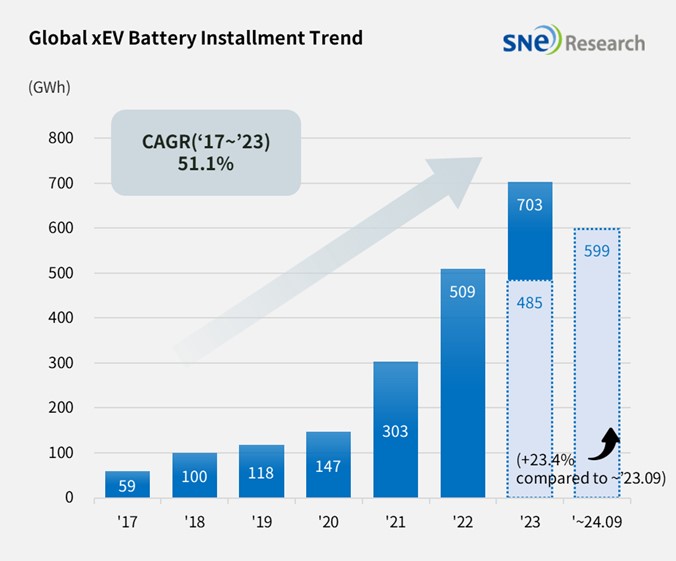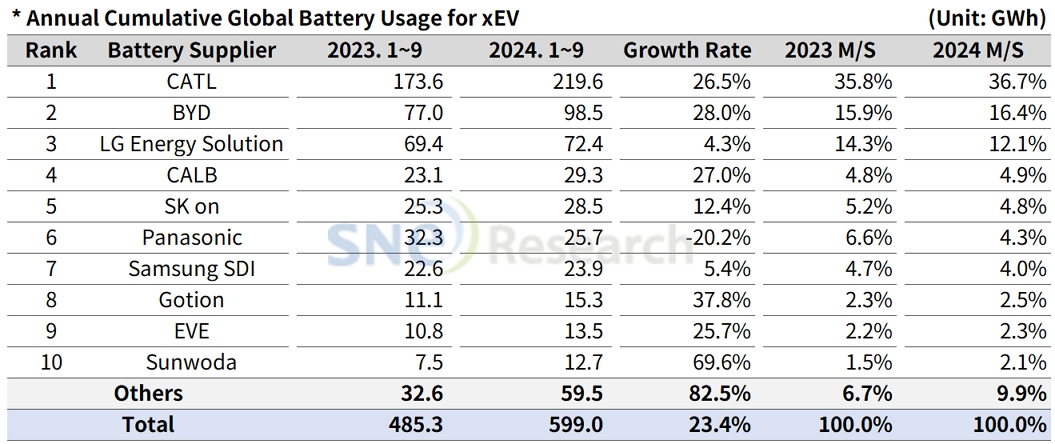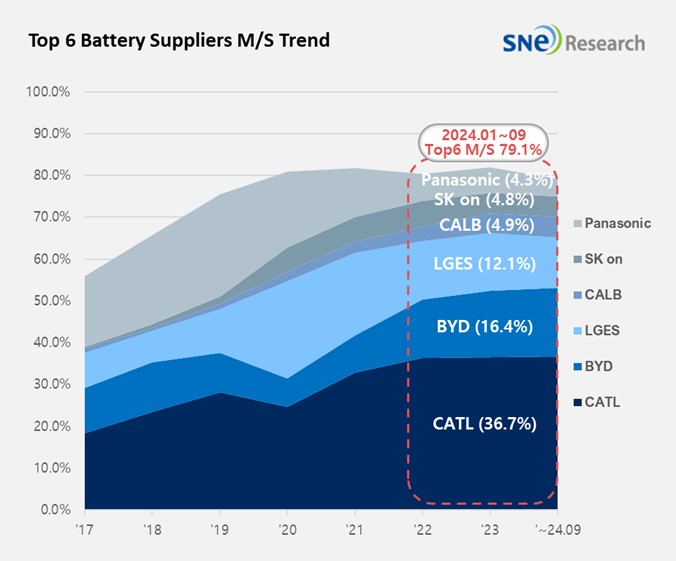From Jan to Sep 2024, Global[1] EV Battery Usage[2] Posted 599.0GWh, a 23.4% YoY Growth
- From Jan to Sep 2024, K-trio’s M/S recorded 20.8%
From
January to September 2024, the amount of energy held by batteries for electric
vehicles (EV, PHEV, HEV)
registered worldwide was approximately 599.0GWh, a 23.4% YoY growth.

(Source: 2024 Oct Global Monthly EV and Battery Monthly Tracker, SNE Research)
The combined usage of batteries made by the K-trio companies for electric vehicles from Jan to September 2024 were higher than that from the same period of last year. LG Energy Solution stayed at the 3rd place in the ranking with a 4.3%(72.4GWh) YoY growth, while SK On ranked 5th with a 12.4%(28.5GWh) growth. Samsung SDI posted a 5.4%(23.9GWh) YoY growth. On the other hand, the combined shares of K-trio in the global market were 20.8%, declined by 3.4%p compared to the same period of last year.

(Source: 2024 Oct Global Monthly EV and Battery Monthly Tracker, SNE Research)
If we look at the usage of battery made by the K-trio in terms of the sales volume of models, Samsung SDI continued to be in an upward trend thanks to favorable sales of BMW and Rivian. Other than these, Audi Q8 e-Tron and JEEP Wranlger PHEV also showed solid sales last month.
SK On also registered growth in the usage of its battery based on the sales of Hyundai Motor Group, Mercedes, Ford, and Volkswagen. Despite a slowdown in sales earlier this year, Hyundai’s IONIQ 5, EV6, and EV9; Mercedes Benz EQA and EQB; and Ford F-150 Lightning all saw a recovery in sales, leading the growth in the usage of SK On’s battery.
LG Energy Solution stayed in an upward trend in the usage of its battery as EV models popular in Europe and North America – Tesla Model 3/Y, VW ID.4, Ford Mustang Mach-E, and GM Cadillac LYRIQ – showed solid sales in those regions. Other than these, the sales of Hyundai IONIQ 6 and KONA Electric in Europe, to which LG Energy Solution’s battery is installed, significantly increased compared to the same period of last year.
From Jan to Sep 2024, sales of EV (BEV+PHEV), except HEV, in Europe posted approximately 1.4% degrowth compared to the same period of last year. With Tesla also posting a degrowth in sales, the usage of LG Energy Solution’s battery in Europe has declined. However, the sales of electric vehicles, to which battery made by Samsung SDI and SK On are installed, were favorable, leading to an overall increase in the usage of K-battery.
Panasonic, the only Japanese company in the top 10 on the list, recorded 25.7GWh from Jan to Sep this year, ranking 6th on the list but recording a 20.2% YoY degrowth. The major reason for Panasonic’s degrowth was a slowdown in sales of Tesla Model 3 due to its transformation to the facelifted version earlier this year. As sales of Model 3 have recently expanded and Panasonic was reported to launch advanced 2170 and 4680 cells supplied to Tesla, Panasonic is expected to rapidly regain its market share mainly focusing on Tesla.
CATL stayed No. 1 in the global ranking with a 26.5%(219.6GWh) YoY growth. Major Chinese OEMs, such as ZEEKR, AITO, and Li Auto in the Chinese domestic market – the world’s largest electric vehicle market – have CATL’s battery inside, and global major OEMs also chose CATL’s battery for their vehicles such as Tesla Model 3/Y, BMW iX, Mercedes EQ series, and VW ID series.
BYD ranked 2nd on the list with a 28.0%(98.5GWh) YoY growth. Amidst the increasing competition among global OEMs for hybrid technologies, BYD has been aggressively targeting the BEV and PHEV markets by launching a new, hybrid vehicle which can drive 2,100km per charge. BYD has been increasing its market shares at a rapid pace not only in the Chinese domestic market but also in Asia and Europe. The combined market shares of No.1 and 2 on the list – CATL and BYD – are already more than half of the entire global market share.

(Source: 2024 Oct Global Monthly EV and Battery Monthly Tracker, SNE Research)
The K-trio and Chinese major battery makers have released their sales and results in Q3, 2024. While CATL boasted a 25.6% YoY increase in net profit, BYD celebrated a monumental moment as it first outperformed Tesla in sales. The K-trio battery makers were relatively sluggish in sales growth and profit rate, but they are trying to diversify their mid/long-term market response measures. Such high growth of Chinese battery companies has started since NCM was replaced with LFP of which price competitiveness and thermal safety are higher than NCM. Starting with China, other regions have been preparing for mass production of LFP at a rapid pace as many global OEMs chose to adopt LFP. While the K-trio may find an opportunity in the US where worries about competitions with China have been lessened and AMPC tax credit would be provided, they could find it difficult in Europe. Recently, as Europe strengthened its regulations on carbon emissions, the Korean battery makers may see an increase in sales in the region. Nevertheless, uncertainties still exist in Europe where AMPC tax credit is not offered. It has become more important for the K-trio to reinforce their strategic partnership with OEMs in the US and Europe as well as secure new customers.
[1] The
xEV sales of 80 countries are aggregated.
[2] Based on battery installation for xEV registered during the relevant period.

